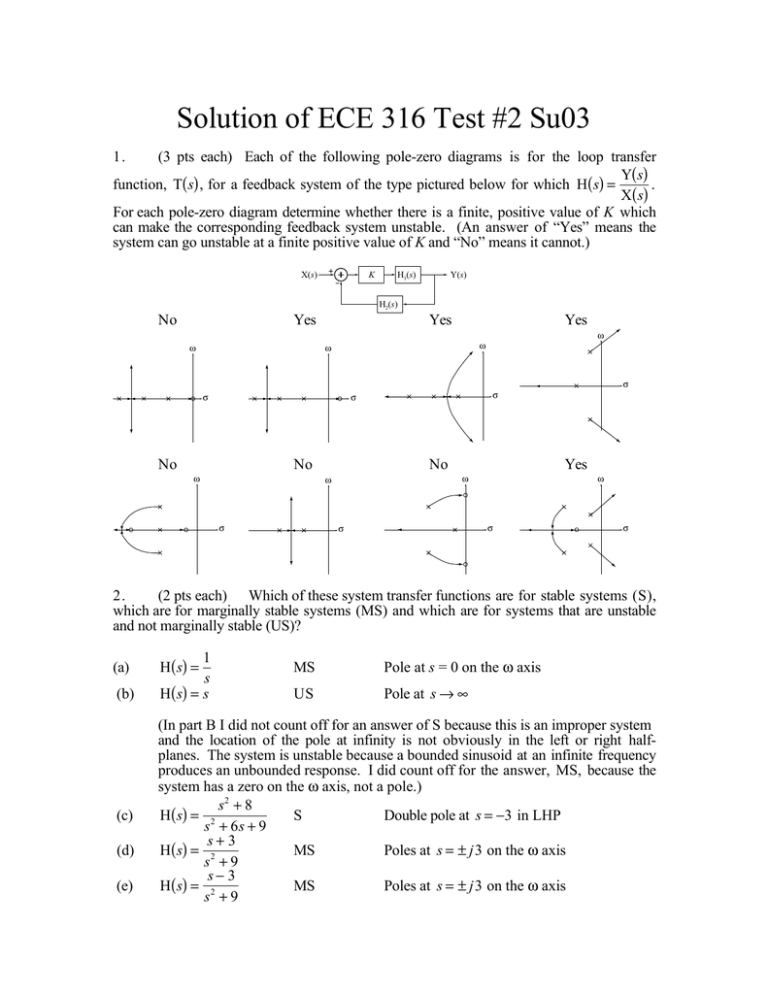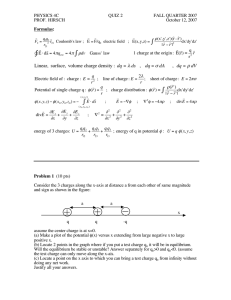Solution of ECE 316 Test #2 Su03 ( )
advertisement

Solution of ECE 316 Test #2 Su03 1. (3 pts each) Each of the following pole-zero diagrams is for the loop transfer Y( s) function, T( s) , for a feedback system of the type pictured below for which H( s) = . X( s) For each pole-zero diagram determine whether there is a finite, positive value of K which can make the corresponding feedback system unstable. (An answer of “Yes” means the system can go unstable at a finite positive value of K and “No” means it cannot.) X(s) K Y(s) H1(s) H2(s) No Yes ω Yes Yes σ No ω No σ Yes ω ω σ σ σ No ω ω ω ω σ σ σ 2. (2 pts each) Which of these system transfer functions are for stable systems (S), which are for marginally stable systems (MS) and which are for systems that are unstable and not marginally stable (US)? (a) (b) (c) (d) (e) 1 s H( s) = s H( s) = MS Pole at s = 0 on the ω axis US Pole at s → ∞ (In part B I did not count off for an answer of S because this is an improper system and the location of the pole at infinity is not obviously in the left or right halfplanes. The system is unstable because a bounded sinusoid at an infinite frequency produces an unbounded response. I did count off for the answer, MS, because the system has a zero on the ω axis, not a pole.) s2 + 8 S Double pole at s = −3 in LHP H( s) = 2 s + 6s + 9 s+3 H( s) = 2 MS Poles at s = ± j 3 on the ω axis s +9 s− 3 H( s) = 2 MS Poles at s = ± j 3 on the ω axis s +9 (f) (g) s2 + 8 s2 − 6 s + 9 1 H( s) = s( s − 3) H( s) = US Double pole at s = +3 in RHP US Poles at s = 0 on the ω axis and s = +3 in RHP 3. (2 pts each) Which of the systems in the previous problem have impulse responses, h( t) , which approach a finite definite value as t → +∞? (Circle those that do.) The final value theorem applies to (a) (b) (c) 4. (1 pt) When an LTI system is excited by its eigenfunction, which is the complex exponential function , its response is of the same functional form and multiplied by a constant. (I did not accept the answer “a linear combination of complex exponentials”. This describes the form of the homogeneous solution of the differential equation, not the eigenfunction.) 5. (1 pt) There are functions which do not have a Fourier transform, even in the generalized sense in which the transform can include impulses, but do have a Laplace transform. True 6. (1 pt) If the region of convergence of a Laplace transform, X( s) , contains the ω axis then the Fourier transform, X( jω ) , of the same function can be found by simply replacing s by jω in X( s) . 7. Find the inverse Laplace transforms, x( t) , of the following functions. (a) (3 pts) X( s) = e −4 s s L u( t) ← → Using the time shifting property, 1 s e −4 s x( t) = u( t − 4 ) ←→ s L (b) 2s (s + 1)(s + 8) 2 16 − 2 2 16 X( s) = 7 + 7 ⇒ x( t) = e −8 t − e − t u( t) = (8e −8 t − e − t ) u( t) 7 7 7 s +1 s + 8 (6 pts) X( s) = (c) 2 s2 (8 pts) X( s) = (s + 1)(s + 8) 128 2 − 18 s + 16 2 s2 7 X( s) = = 2− = 2− + 7 (s + 1)(s + 8) (s + 1)(s + 8) s + 1 s + 8 2 128 −8 t 2 x( t) = 2δ ( t) − − e − t + e u( t) = 2δ ( t) + (e − t − 64 e −8 t ) u( t) 7 7 7 8. (1 pt) An LTI system that oscillates indefinitely without an apparent excitation must have a pair of poles located on the ω axis. (The answer, “on the ω axis “ is what I was looking for but, because of the way the problem was worded, I also accepted “on the ω axis or in the right half-plane”. If the poles are in the right half-plane, the signal oscillates indefinitely but with an increasing amplitude.)





